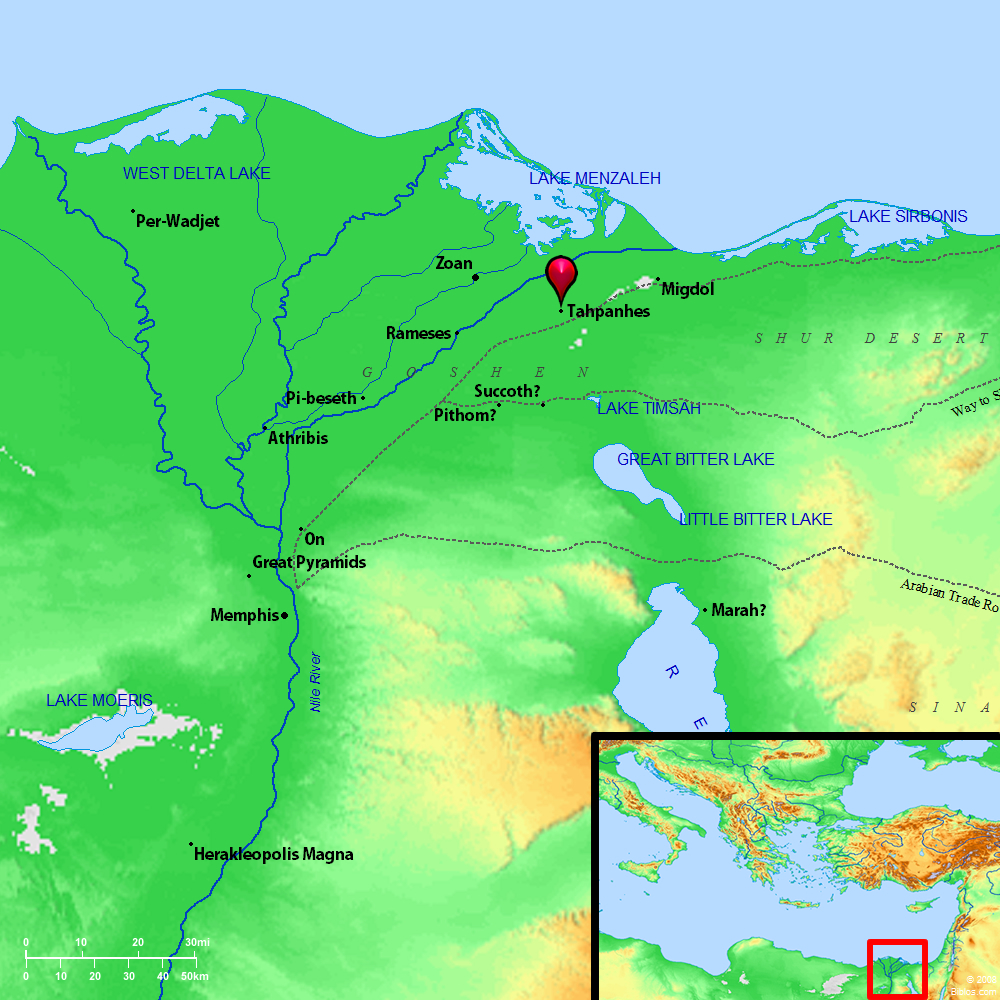Atlas  Tahpanhes and surrounding region Maps Created using Biblemapper 3.0 Additional data from OpenBible.info You are free to use up to 50 Biblos coprighted maps (small or large) for your website or presentation. Please credit Biblos.com. Occurrences Jeremiah 2:16 The children also of Memphis and Tahpanhes have broken the crown of your head.Jeremiah 43:7 and they came into the land of Egypt; for they didn't obey the voice of Yahweh: and they came to Tahpanhes. Jeremiah 43:8 Then came the word of Yahweh to Jeremiah in Tahpanhes, saying, Jeremiah 43:9 Take great stones in your hand, and hide them in mortar in the brick work, which is at the entry of Pharaoh's house in Tahpanhes, in the sight of the men of Judah; Jeremiah 44:1 The word that came to Jeremiah concerning all the Jews who lived in the land of Egypt, who lived at Migdol, and at Tahpanhes, and at Memphis, and in the country of Pathros, saying, Jeremiah 46:14 Declare in Egypt, and publish in Migdol, and publish in Memphis and in Tahpanhes: say, Stand forth, and prepare; for the sword has devoured around you. Encyclopedia TAHPANHESta'-pan-hez, ta-pan'-hez (usually in the Old Testament tachpanchec; Septuagint Taphnas; Coptic, Taphnes): The various spellings of the Hebrew text are fairly well indicated in the King James Version by Tahapanes (Jeremiah 2:16); Tahpanhes (Jeremiah 43:7-9; Jeremiah 44:1; Jeremiah 46:14); Tehaphnehes (Ezekiel 30:18), while an Egyptian queen (XXIst Dynasty) is named Tahpenes (1 Kings 11:19, 20). Tahpanhes was a city on the eastern frontier of Lower Egypt, represented today by Tell Defenneh, a desert mound lying some 20 miles Southwest from Pelusium (Biblical "Sin") and a little North of the modern Al-Kantarah ("the bridge"), marking the old caravan route from Egypt to Palestine, Mesopotamia and Assyria. Its Egyptian name is unknown, but it was called Daphnai, by the Greeks, and by the modern Arabs Def'neh. The site is now desolate, but it was a fertile district when watered by the Pelusiac branch of the Nile (compare Isaiah 19:6, 7). Tahpanhes was so powerful that Jeremiah can say that it, with Memphis, has "broken the crown" of Israel's head (2:16), and Ezekiel can speak of its "daughters" (colonies or suburban towns), and names it with Heliopolis and Bubastis when the "yokes Septuagint "sceptres") of Egypt" shall be broken by Yahweh (30:18). In a later passage Jeremiah describes the flight of the Jews from their ruined capital to Tahpanhes after the death of Gedaliah (43:1-7) and prophesies that Nebuchadnezzar shall invade Egypt and punish it, establishing his throne upon the brick pavement (the King James Version "kiln") which is at the entry of Pharaoh's royal palace at Tahpanhes (Jeremiah 43:8-11). He calls Tahpanhes as a witness to the desolation of the cities of Judah (Jeremiah 44:1), but prophesies an equal destruction of Tahpanhes and other Egyptian cities (probably occupied by fugitive Jews) when Nebuchadnezzar shall smite them (Jeremiah 46:14). TAHAP'ANES, of Jer. 2:16 is the same as Tah'-panhes and Tehaphnehes and probably the same as Hanes of Is. 30:4. The ruins of this city have been recently examined and the ancient name identified with a large series of mounds at tell Defenneh, 78 ms.e.n.e. of Cairo, upon the most eastern branch, or near the ancient Pelusian arm of the Nile. In 1886 Mr. Petrie discovered the palace described by Jer. 43, to which in about 585 Benjamin C., during the reign of Hophra, king of Egypt, the daughters of Zedekiah fled and in which they were received by that Pharaoh. It has for years been called "the castle of the Jew's daughter" and is visible from a great distance. Strong's Hebrew H8471: Tachpanches or Techaphnechesa city in Egypt |



